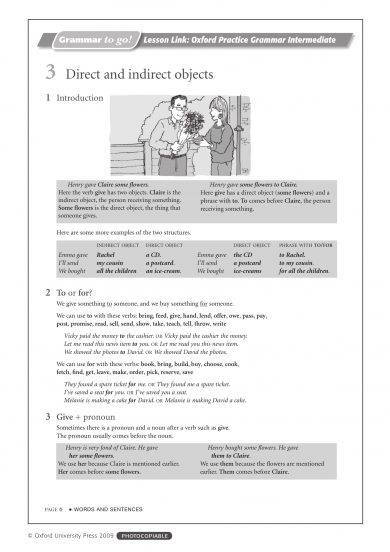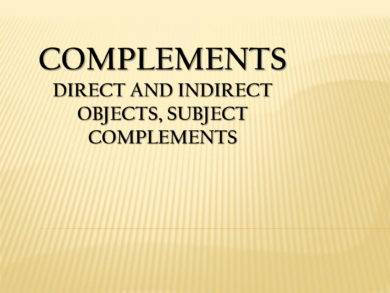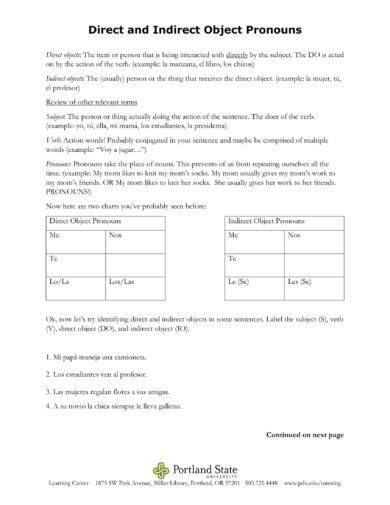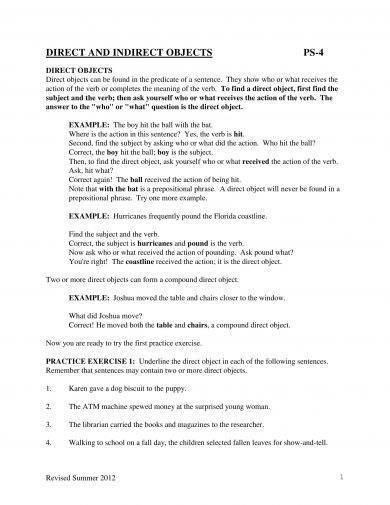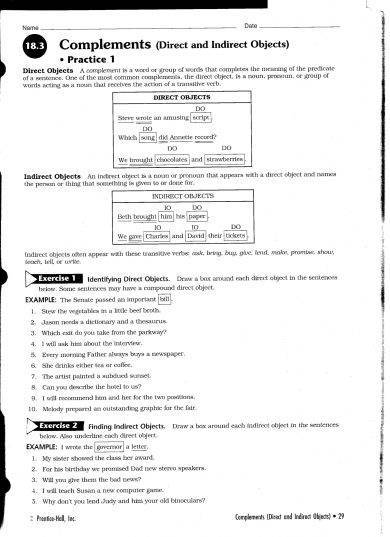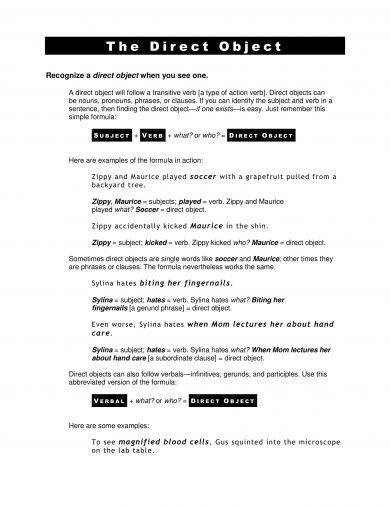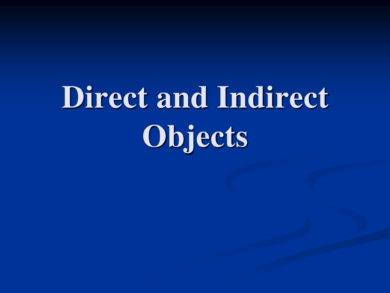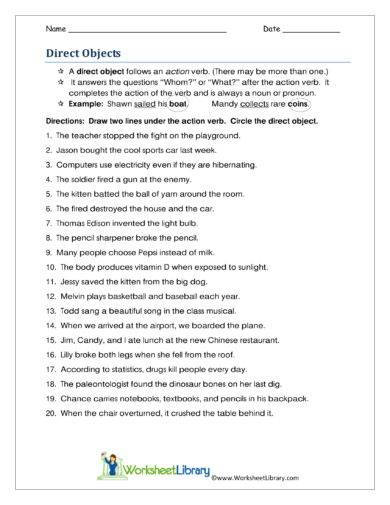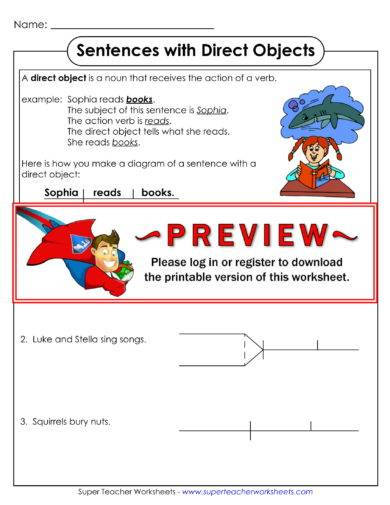9+ Direct Object Examples
Typically, in sentences that contain action verbs, they also feature objects of the verbs that gives the reader further information about the action verb through specifying and giving details about it, for example, by telling what received the action or to whom the action was performed. These are called object, and whether it may be direct or indirect depends on the role that they play in a sentence. You may also see time worksheets examples.
Many people would confuse direct objects as a verb complement. To simplify, you can determine a verb complement if you ask “what?” with a linking verb.
On the other hand, you can determine a direct object by asking “what?” or “whom?” More on this discussion can be found in the later part of this section. Additionally, examples, discussion, notes, and worksheets with regard to direct objects can be found in the next section below. You may also like grammar worksheets.
Concise Discussion on Direct Objects and Indirect Objects
Detailed Discussion on Direct Objects and Indirect Objects
Direct and Indirect Object Pronouns Example
Direct Object Defined and Explained
Direct object is a noun, pronoun, or another part of speech functioning as a noun that receives the action of the sentence. It will always follow a transitive verb. It can simply be described as the thing being acted upon or the receiver of the action, telling who or what received it. You may also see geometry worksheet examples for students.
Direct objects can be determined by finding the verb and asking yourself a question “what?” or “whom?”
For example:
- Jessie will write her article tomorrow.
In this sentence, the verb is “will write.” Then, ask yourself, “will write what?” The answer is the direct object. Hence, the direct object of this sentence is “article.” You may also like alphabet worksheet examples.
- We can ride the boat or climb the mountain.
In this second sentence, there are two verbs, “ride” and “climb.” Ride what? Climb what? Hence, the direct objects are “boat” and “mountain,” respectively.
- James throws his pillow.
The verb in this sentence is “throws,” so the direct object must be “pillow.”
At this point, you may have already understood the basics, which is important, in determining the direct object of the sentence. You may also check out multiplication worksheets examples.
Here are other examples of sentences with direct objects. Can you determine the direct objects for each sentence?
- Joel dialed an incorrect number on his phone.
- The fans cheered their respective favorite actors during the show.
- Shane draw a portrait for his friend Fel.
- The organization held a session for live portrait last night.
- The team conducted their research in the field.
- Ash choose Pikachu as his starter Pokemon.
- Naruto protected his village from the villains.
- Ben studied algebra but slept in the process.
- Rapunzel throws her hair out the window.
- Fritz wrote a love letter for Jen.
You might be interested in expense worksheet examples.
Nouns as Direct Objects
Nouns, words that names a person, place, thing, or idea, can act as a direct objects. Here are several examples of such.
- I can hardly see the signage.
- John’s confession shattered Joan’s entire being.
- I listed Larry’s name on the waiting list.
- He ate the pineapple tart.
- Craig watched the basketball game on the television.
- My mom only eats cereal for breakfast.
- Chelsie played the lead guitar during their concert.
- The dog saw the cat through the window.
- The father patted the dog on its head.
- Jan rode her bike to the office.
You may also see kindergarten worksheet examples.
Pronouns as Direct Objects
Here are several examples of pronouns acting as direct objects.
- I took her with me to the concert.
- Our teacher hired us to paint the school mural.
- The celebrant invited them to her birthday party.
- His confession shattered her entire being.
- She waited for him to pick him up.
- His best friend picked us up at the airport.
- Elaine smashed him right on his nose.
- Our class president sent me an invitation letter.
- The owner left us in his store.
- One student kicked him in the butt.
You may also like science worksheets examples for students.
Direct and Indirect Objects Discussion and Examples
Direct and Indirect Objects Practice Sheet Example
Direct Object Discussion and Examples
Direct Objects, Indirect Objects, and Notes Example
Phrases and Clauses as Direct Objects
Phrases and clauses can also act as direct objects such as in these example sentences:
- The employee thought his contract with the company had ended.
- The witnesses described what they observed from the crime scene.
- Typically, cats want to eat fishes.
- Mae hates drinking cold coffee.
- He likes women who bake pies and enjoy rock climbing.
- The typhoon destroyed the tall building next to the ancient basketball court.
- The mother cat disciplined her naughty kittens.
- A seller reserved the house and lot that we would be buying.
- Your mom appreciates that you pulled the weeds in the garden.
- I admire how she works during the day and paint during the night.
You may also see division worksheet examples.
Compound Direct Objects
Here are several examples of compound direct objects.
- Jerry took his lunch box and bag out of his car.
- The waiter placed the spoons and forks on the tables.
- He brought coffee and creamer in the office.
- I walked my dog and my cat in the park the other day.
- Our family driver drove my brother and me to the school.
- My sister bought yogurt and juice from the nearby grocery store.
- Jed saw a dragon and a unicorn in his dreams.
- Jing carried her documents and reports toward her desks.
- Her mother cooked vegetables and meat for dinner.
- I love his stares and smiles.
You may also like punctuation worksheet examples.
Direct Objects versus Indirect Objects
There are times when we get confused with direct objects and indirect object. They are similar in a way that they follow and give meaning to the subject and verb in a sentence.
Direct object is already explained above, and now, we will compare it with indirect objects. As has been said, a direct object can be identified by determining the verb and asking “what?” or “whom?” On the other hand, indirect object can be determined by asking who or what received the direct object. It usually precedes the direct object. It identifies to whom or for whom the action of the verb is performed. You may also check out budget worksheet examples.
Direct Objects versus Subject Complement
A subject complement can usually be mistaken for direct objects. To avoid this, you must know that the subject complement follows a linking verb such as is, are, or was and completes the subject of a sentence by describing or renaming it. For example, “He was happy to find the lost key.” You might be interested in coaching worksheet examples.
Direct Object Worksheets and Examples
Finding Direct Object Worksheet
Sentences with Direct Object Examples
Direct Objects in Literature
Here are some sentences from books and other publications that contain direct objects. For clarity, the direct objects in the sentences are rendered in italics.
1. “I could catch a monkey. If I was starving I could. I’d make poison darts out of the poison of the deadly frogs. One milligram of that poison can kill a monkey.” You may also see debate worksheet examples.
(Mackenzie Crook as Gareth in “Work Experience.” The Office, 2001)
2. “We tell ourselves stories in order to live.”
(Joan Didion, The White Album. Simon & Schuster, 1979)
3. “Momma opened boxes of crispy crackers . . . . I sliced onions, and Bailey opened two or even three cans of sardines.” You may also like newspaper worksheet examples.
(Maya Angelou, I Know Why the Caged Bird Sings. Random House, 1969)
4. “[The developers] bulldozed the banks to fill in the bottom, and landscaped the flow of water that remained.”
(Edward Hoagland, “The Courage of Turtles.” The Village Voice, December 12, 1968)
5. “She closed the carton carefully. First she kissed her father, then she kissed her mother. Then she opened the lid again, lifted the pig out, and held it against her cheek.” You may also check out writing worksheet examples.
(E.B. White, Charlotte’s Web. Harper & Brothers, 1952)
6. “But if thought corrupts language, language can also corrupt thought.” You may also see fraction worksheets examples.
(George Orwell, “Politics and the English Language,” 1946)
7. “You can’t test courage cautiously.”
(Annie Dillard, An American Childhood. Harper & Row, 1987)
8. “Dinsdale, he was a nice boy. He nailed my head to a coffee table.” You might be interested in biography worksheet examples.
(Monty Python)
9. “Some transitive phrasal verbs do not use their direct object when the direct object is implied in the meaning of the idiom. For example, with the phrasal verb pull over (to move a vehicle out of the flow of traffic, and slow down or stop), it’s not necessary to say ‘I pulled the car over’ because the car is implied by the idiom. You can simply say ‘I pulled over.’ However, . . . a direct object is required when the action is directed at someone else. For example, when police officers direct someone to pull a vehicle off the road and stop, a direct object is required: the officer pulls over someone.” You may also like project worksheet examples.
(Gail Brenner, Webster’s New World American Idioms Handbook. Wiley, 2003)
10. “In English clauses with both a direct and an indirect object, there are two common orders of these phrases. If the indirect object is marked by a preposition (usually to), the direct object comes immediately after the verb, and the phrase with the indirect object comes after that, as in I sent a letter to my love, where a letter is the direct object of sent. You may also see resume worksheet examples.
In the alternative order, there is no preposition, and the direct object is the second of the two noun phrases, as in I sent my love a letter (where a formal letter is still the direct object of sent).”
(James R. Hurford, Grammar: A Student’s Guide. Cambridge University Press, 1994)
Insights
A direct object is the one that receives the action in a sentence. It may be a noun, a pronoun, or any part of speech that functions as a noun. To determine the direct object, you must first identify the verb, then ask “what?” or “whom?” It can usually be confused with indirect objects and subject complements, which are fully discussed above. You may also see reading comprehension worksheet examples.
We do hope that you have understood well everything about direct object and that the examples, templates, and worksheets above helped you to fully understand the subject matter.




